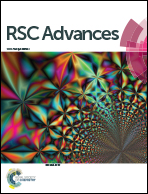Interactions between hydrogen and tungsten carbide: a first principles study†
Abstract
Tungsten carbide has been proposed to be a potential inexpensive alternative to platinum for catalyzing hydrogenation reactions. Using density functional theory (DFT) calculations, we performed a systematic study on the geometries and electronic structures of small (WC)n (n = 1–10) clusters. A cubic-like growth of WC clusters was found to be the preferred pathway. The interactions between the WC clusters and hydrogen were compared to interactions of hydrogen with the WC(0001) surface. Both atomic clusters and the crystalline surface of WC can lead to facile dissociation of H2 while the activation energy on the former is even lower; the H diffusion barrier on WC clusters was found to be significantly higher than that on the WC(0001) surface, yet both of the calculated diffusion barriers are well above the values on the platinum counterpart. The lack of hydrogen mobility may exert a profound influence on the kinetics of hydrogen for participating in reactions on WC. The desorption strength of H on (WC)n (n = 2, 4, 6, 9) at various hydrogen coverages was explored and the hydrogen saturated (WC)9 cluster was used to rationalize the catalytic formation of hydrogen tungsten bronzes. The study provides insights which may be useful for efforts to replace Pt with WC in catalytic processes involving hydrogen.


 Please wait while we load your content...
Please wait while we load your content...